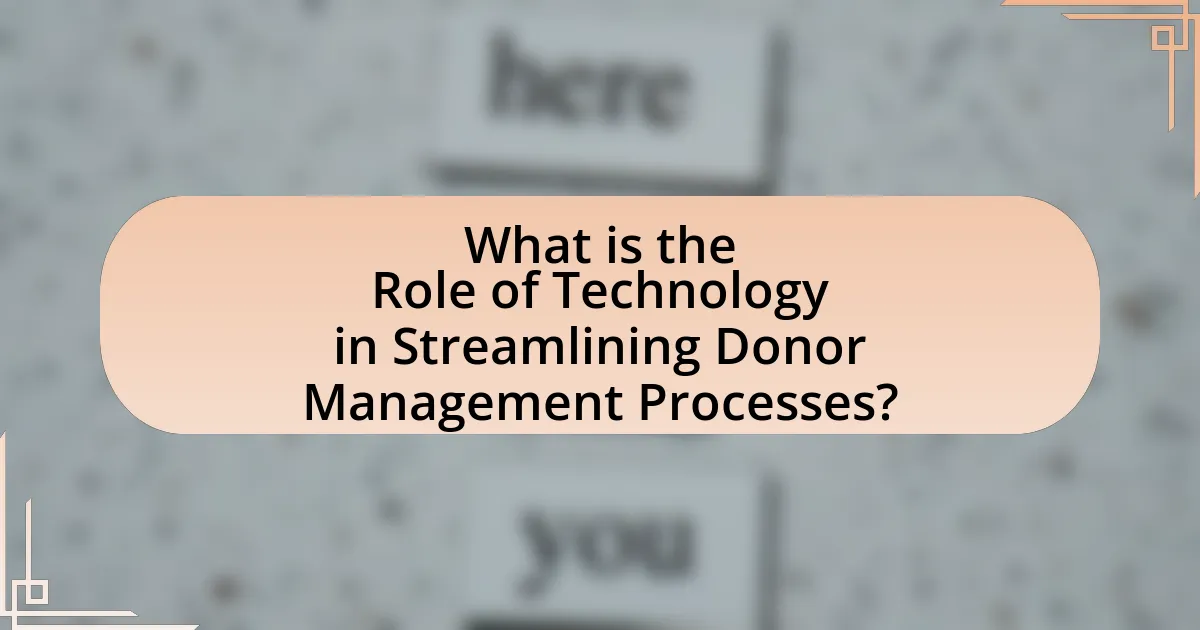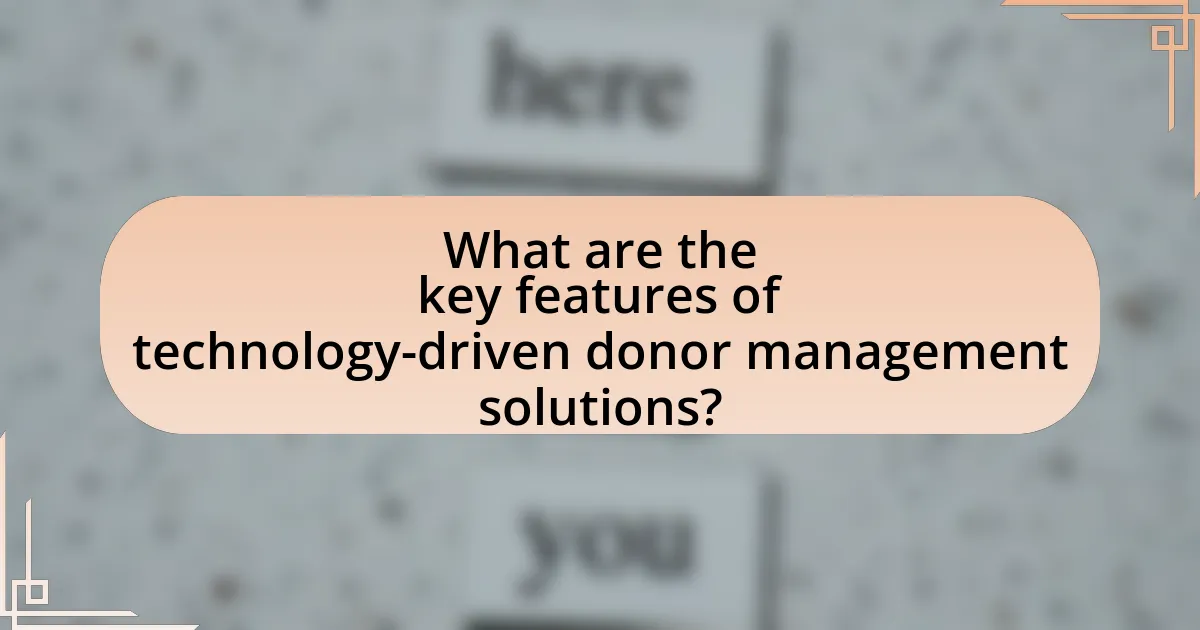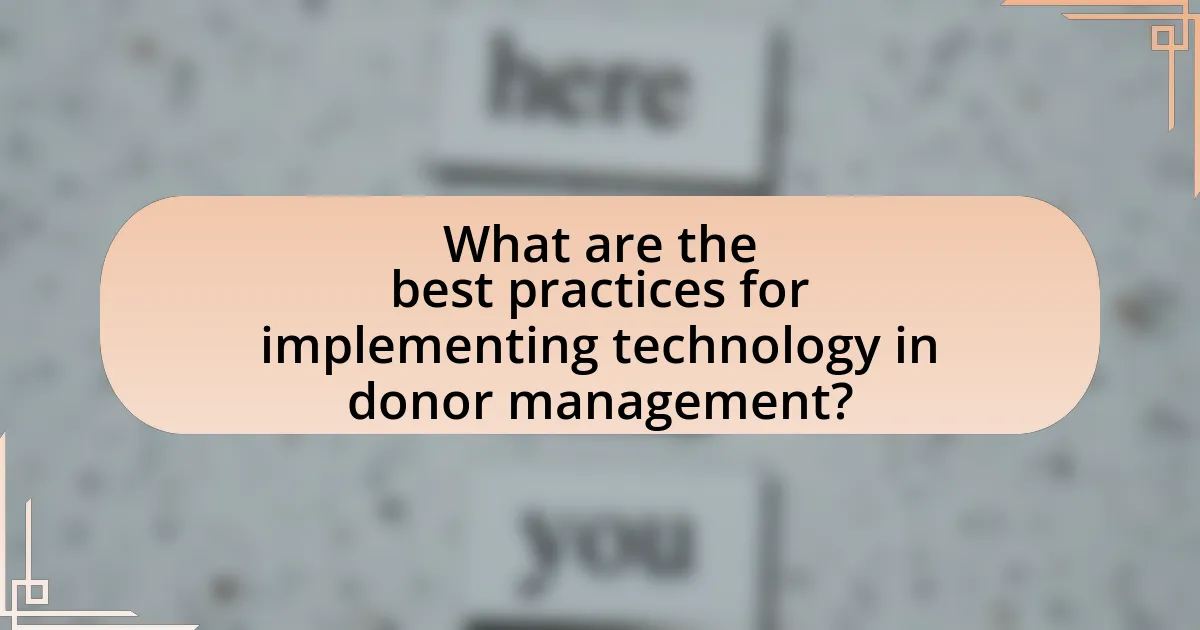The article focuses on the critical role of technology in streamlining donor management processes within organizations. It highlights how automation, enhanced communication, and data analytics improve efficiency, accuracy, and donor engagement. Key technologies discussed include Customer Relationship Management (CRM) systems, online donation platforms, and automated communication tools, all of which contribute to better data collection and analysis. The article also addresses the importance of effective donor management for fundraising success, the challenges organizations face without streamlined processes, and best practices for implementing technology in donor management.
What is the Role of Technology in Streamlining Donor Management Processes?

Technology plays a crucial role in streamlining donor management processes by automating tasks, enhancing communication, and providing data analytics. Automation reduces manual entry errors and saves time, allowing organizations to focus on building relationships with donors. Enhanced communication tools, such as CRM systems, facilitate personalized outreach and engagement, improving donor retention rates. Additionally, data analytics enable organizations to track donor behavior and preferences, leading to more targeted fundraising strategies. According to a study by Blackbaud, organizations that utilize technology in donor management see a 20% increase in donor retention compared to those that do not.
How does technology enhance donor management systems?
Technology enhances donor management systems by automating data collection and analysis, which improves efficiency and accuracy in tracking donor interactions. For instance, customer relationship management (CRM) software allows organizations to consolidate donor information, manage communications, and analyze giving patterns, leading to more personalized engagement strategies. According to a study by Blackbaud, organizations using advanced donor management technology reported a 20% increase in donor retention rates, demonstrating the effectiveness of these systems in fostering long-term relationships with donors.
What specific technologies are utilized in donor management?
Specific technologies utilized in donor management include Customer Relationship Management (CRM) systems, online donation platforms, data analytics tools, and automated communication software. CRM systems, such as Salesforce and Blackbaud, help organizations track donor interactions and manage relationships effectively. Online donation platforms like PayPal and GiveLively facilitate secure transactions and streamline the donation process. Data analytics tools enable organizations to analyze donor behavior and optimize fundraising strategies. Automated communication software, such as Mailchimp, enhances engagement through personalized messaging and follow-ups. These technologies collectively improve efficiency and effectiveness in managing donor relationships.
How do these technologies improve data collection and analysis?
Technologies improve data collection and analysis by automating processes, enhancing accuracy, and enabling real-time insights. Automation reduces human error and speeds up data entry, while advanced analytics tools allow organizations to process large datasets efficiently. For instance, customer relationship management (CRM) systems can aggregate donor information from multiple sources, providing a comprehensive view of donor behavior and preferences. This integration facilitates targeted communication strategies, ultimately leading to improved donor engagement and retention.
Why is streamlining donor management important for organizations?
Streamlining donor management is important for organizations because it enhances efficiency and improves donor relationships. Efficient donor management systems reduce administrative burdens, allowing organizations to allocate more resources toward their mission. For instance, a study by the Association of Fundraising Professionals found that organizations with streamlined donor management processes experienced a 20% increase in donor retention rates. This increase is crucial as retaining existing donors is often more cost-effective than acquiring new ones. Additionally, streamlined processes enable organizations to analyze donor data effectively, leading to more personalized communication and engagement strategies, which further strengthens donor loyalty.
What challenges do organizations face without streamlined processes?
Organizations face significant challenges without streamlined processes, including inefficiencies, increased operational costs, and reduced employee productivity. Inefficiencies arise from duplicated efforts and miscommunication, leading to delays in project completion. Increased operational costs occur due to wasted resources and time, which can be quantified; for instance, a study by McKinsey found that organizations can improve productivity by 20-25% through process optimization. Reduced employee productivity results from frustration and confusion over unclear workflows, which can lead to higher turnover rates. These challenges collectively hinder an organization’s ability to effectively manage donor relationships and achieve its goals.
How does effective donor management impact fundraising efforts?
Effective donor management significantly enhances fundraising efforts by fostering stronger relationships with donors, leading to increased donations. When organizations utilize technology to track donor interactions, preferences, and giving history, they can tailor their communication and engagement strategies, resulting in higher donor retention rates. For instance, studies show that organizations with effective donor management systems can increase donor retention by up to 30%, directly impacting overall fundraising success. This systematic approach allows for personalized outreach, timely follow-ups, and targeted campaigns, ultimately driving more substantial financial support for the organization’s mission.
What are the key features of technology-driven donor management solutions?

Technology-driven donor management solutions primarily feature centralized databases for donor information, automated communication tools, and analytics for tracking donor engagement. Centralized databases allow organizations to store and manage donor data efficiently, ensuring easy access and updates. Automated communication tools facilitate timely and personalized outreach, enhancing donor relationships and retention. Analytics capabilities enable organizations to assess donor behavior and campaign effectiveness, leading to data-driven decision-making. These features collectively streamline donor management processes, improve engagement, and optimize fundraising efforts.
How do automation tools contribute to donor management?
Automation tools significantly enhance donor management by streamlining processes such as data entry, communication, and reporting. These tools automate repetitive tasks, reducing the likelihood of human error and freeing up staff time for more strategic activities. For instance, automated donor tracking systems can efficiently manage donor information, track contributions, and generate reports, which improves overall efficiency. According to a study by the Nonprofit Technology Network, organizations that utilize automation tools report a 30% increase in donor engagement and retention, demonstrating the effectiveness of these technologies in optimizing donor management.
What tasks can be automated in the donor management process?
Tasks that can be automated in the donor management process include donor data entry, donation tracking, communication with donors, and reporting. Automating donor data entry reduces human error and saves time by using software to capture and store donor information efficiently. Donation tracking can be streamlined through automated systems that monitor contributions and generate receipts, ensuring accurate financial records. Communication with donors can be automated using email marketing tools that send personalized messages and updates, enhancing donor engagement. Finally, reporting can be automated to generate insights on donor behavior and fundraising performance, allowing organizations to make data-driven decisions.
How does automation improve efficiency and accuracy?
Automation improves efficiency and accuracy by streamlining repetitive tasks and minimizing human error. By implementing automated systems, organizations can process data faster and more reliably, leading to quicker decision-making and enhanced productivity. For instance, a study by McKinsey & Company found that automation can increase productivity by up to 30% in certain sectors by reducing the time spent on manual tasks. Additionally, automated systems ensure consistent data entry and processing, which significantly lowers the risk of mistakes that can occur with manual handling. This combination of speed and precision makes automation a critical component in optimizing donor management processes.
What role does data analytics play in donor management?
Data analytics plays a crucial role in donor management by enabling organizations to analyze donor behavior, preferences, and engagement patterns. This analysis helps organizations tailor their fundraising strategies, optimize communication, and enhance donor retention. For instance, a study by the Association of Fundraising Professionals found that organizations using data analytics saw a 20% increase in donor retention rates. By leveraging data analytics, organizations can identify high-value donors, predict future giving, and allocate resources more effectively, ultimately leading to improved fundraising outcomes.
How can organizations leverage data analytics for donor insights?
Organizations can leverage data analytics for donor insights by analyzing donor behavior, preferences, and engagement patterns to tailor fundraising strategies effectively. By utilizing data analytics tools, organizations can segment donors based on giving history, demographics, and engagement levels, allowing for personalized communication and targeted campaigns. For instance, a study by Blackbaud found that organizations using data analytics saw a 20% increase in donor retention rates, demonstrating the effectiveness of data-driven strategies in enhancing donor relationships and optimizing fundraising efforts.
What metrics are essential for evaluating donor engagement?
Essential metrics for evaluating donor engagement include donor retention rate, average gift size, frequency of donations, and donor lifetime value. Donor retention rate measures the percentage of donors who continue to give over time, indicating loyalty and satisfaction. Average gift size reflects the typical amount donated, which can signal the effectiveness of fundraising strategies. Frequency of donations assesses how often donors contribute, providing insight into their ongoing commitment. Donor lifetime value estimates the total revenue a donor is expected to generate throughout their relationship with the organization, highlighting the long-term impact of engagement efforts. These metrics collectively provide a comprehensive view of donor engagement and inform strategies for improvement.
What are the best practices for implementing technology in donor management?

The best practices for implementing technology in donor management include selecting a user-friendly donor management system, ensuring data security, integrating with existing tools, providing staff training, and regularly evaluating system performance. A user-friendly system enhances adoption rates among staff, while data security protects sensitive donor information, which is crucial given that 60% of nonprofits report data breaches. Integration with existing tools, such as CRM systems, streamlines processes and improves efficiency. Staff training ensures that team members can effectively utilize the technology, leading to better donor engagement. Regular evaluations of system performance help identify areas for improvement and ensure that the technology continues to meet organizational needs.
How can organizations choose the right technology for their needs?
Organizations can choose the right technology for their needs by conducting a thorough assessment of their specific requirements and aligning them with available technological solutions. This involves identifying key functionalities that enhance donor management processes, such as data tracking, communication tools, and reporting capabilities. Research indicates that 70% of organizations that evaluate their technology needs against their operational goals report improved efficiency and donor engagement. By prioritizing features that directly address their unique challenges, organizations can make informed decisions that lead to effective technology adoption.
What factors should be considered when selecting donor management software?
When selecting donor management software, organizations should consider functionality, ease of use, integration capabilities, cost, and customer support. Functionality is crucial as it determines whether the software meets specific needs such as tracking donations, managing donor relationships, and generating reports. Ease of use affects staff adoption and efficiency; software that is intuitive minimizes training time. Integration capabilities are important for ensuring the software can work seamlessly with existing systems like CRM or accounting software, enhancing overall operational efficiency. Cost must be evaluated not only in terms of initial investment but also ongoing fees, as budget constraints are common in nonprofit organizations. Lastly, reliable customer support is essential for resolving issues quickly and ensuring smooth operation, as highlighted by a 2021 survey indicating that 70% of nonprofits prioritize support when choosing software.
How can organizations ensure successful technology adoption?
Organizations can ensure successful technology adoption by implementing a structured change management process. This involves clearly defining the technology’s purpose, providing comprehensive training for users, and establishing ongoing support systems. Research indicates that organizations with effective change management practices are 6 times more likely to achieve their technology adoption goals, as highlighted in a study by Prosci, which emphasizes the importance of employee engagement and communication throughout the adoption process.
What common pitfalls should organizations avoid in donor management technology?
Organizations should avoid several common pitfalls in donor management technology, including inadequate data integration, lack of user training, and neglecting donor engagement strategies. Inadequate data integration can lead to fragmented information, making it difficult to have a comprehensive view of donor relationships. Lack of user training results in underutilization of the technology, as staff may not fully understand how to leverage its features effectively. Neglecting donor engagement strategies can diminish the potential for building long-term relationships, as technology should enhance communication rather than replace personal interactions. These pitfalls can hinder the overall effectiveness of donor management systems and impact fundraising success.
How can organizations prevent data security issues?
Organizations can prevent data security issues by implementing robust cybersecurity measures, including encryption, access controls, and regular security audits. These measures protect sensitive donor information from unauthorized access and breaches. For instance, according to the 2021 Verizon Data Breach Investigations Report, 85% of breaches involved a human element, highlighting the importance of training employees on security protocols. Additionally, adopting multi-factor authentication can significantly reduce the risk of unauthorized access, as it requires multiple forms of verification before granting access to sensitive data. Regularly updating software and systems also mitigates vulnerabilities that could be exploited by cybercriminals.
What strategies can mitigate resistance to technology adoption?
To mitigate resistance to technology adoption, organizations can implement comprehensive training programs that enhance user competence and confidence. Research indicates that effective training reduces anxiety associated with new technologies, leading to higher acceptance rates. Additionally, involving employees in the decision-making process fosters a sense of ownership and reduces apprehension. A study by Venkatesh et al. (2012) found that user involvement significantly correlates with positive attitudes towards technology adoption. Furthermore, providing ongoing support and resources can address concerns and reinforce the benefits of the technology, ultimately facilitating smoother transitions.
What practical tips can enhance the effectiveness of donor management technology?
To enhance the effectiveness of donor management technology, organizations should prioritize data accuracy and integration. Ensuring that donor information is consistently updated and accurately entered into the system allows for better segmentation and targeted communication, which can increase donor engagement. Additionally, integrating donor management technology with other platforms, such as CRM systems and email marketing tools, streamlines processes and improves overall efficiency. Research indicates that organizations utilizing integrated systems experience a 20% increase in donor retention rates, demonstrating the tangible benefits of these practices.